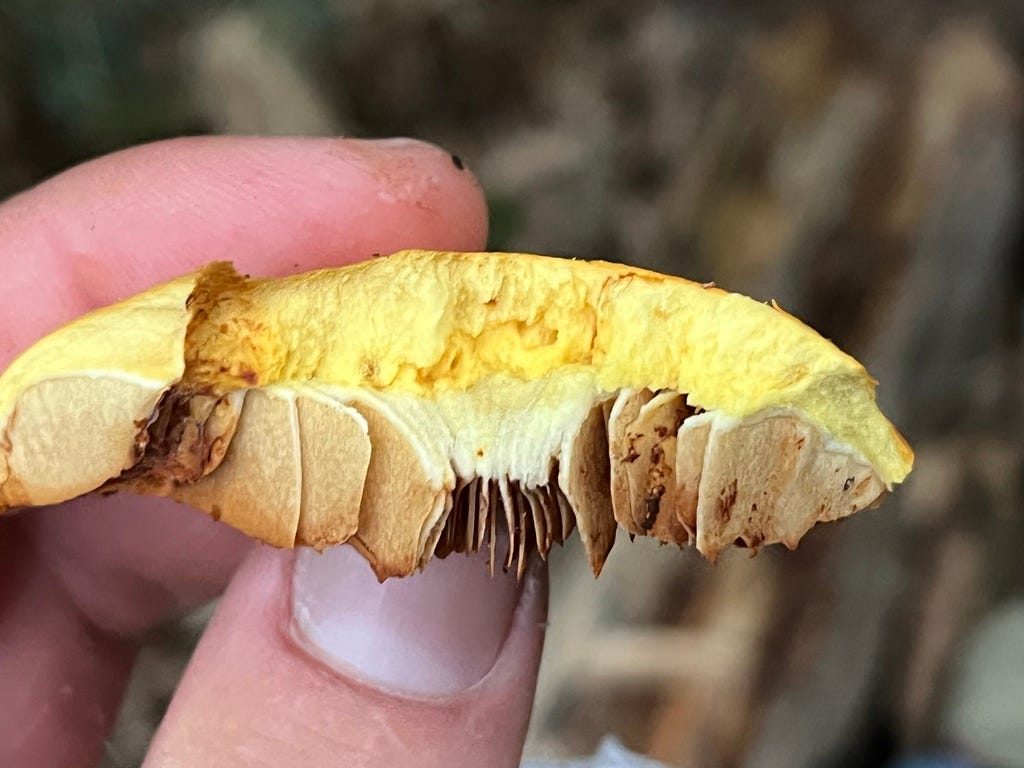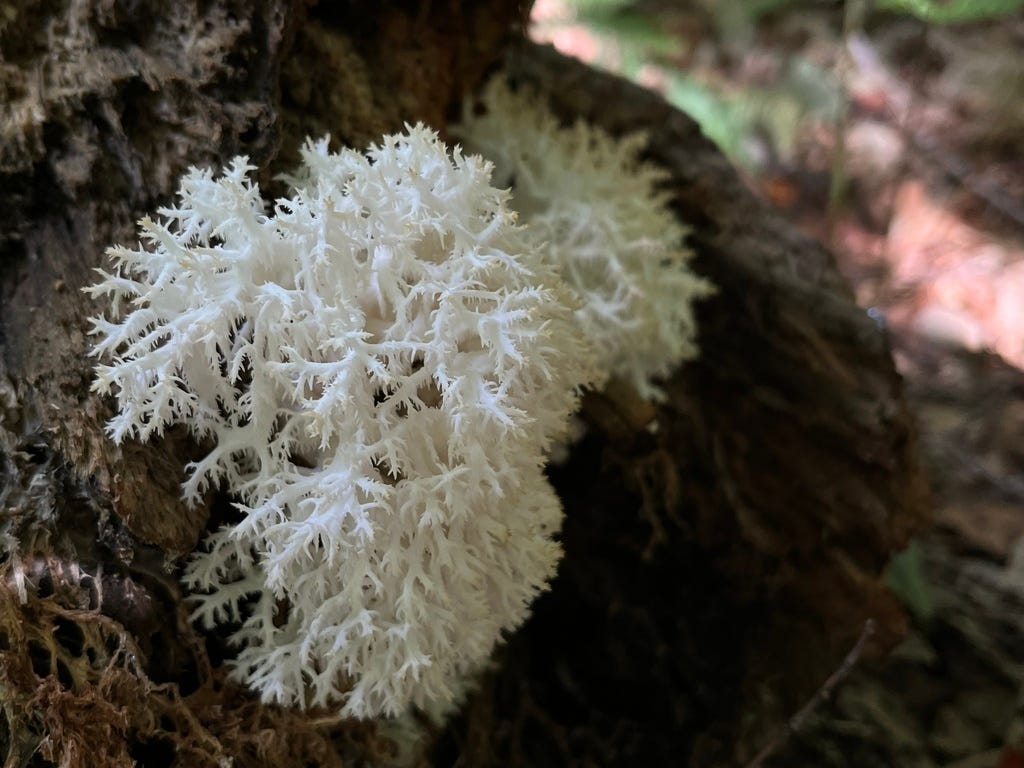Good evening, friends,
This past weekend I hiked thirty or so miles of the Northville-Placid Trail with my buddy Phil. The leaves were just beginning to turn in the Adirondacks so the setting was prime despite the cold rain that followed us most of Saturday. This week we’ll look at a large, fleshy mushroom we found along the trail. Big laughing gyms (Gymnopilus spp.) comprise a complex of different large, wood-rotting, psychoactive species in the genus Gymnopilus. These are mushrooms you may run into this fall so it’s good to know what they do both in the woods and in our bodies.
Fun Facts
There’s a tale in Japanese folklore that dates back to the 11th century and tells the story of a group of woodcutters that got lost in the woods. Amidst their ambling, they stumbled upon a group of buddhist nuns (also lost in the woods, this was pre-google maps) that were singing and dancing. The wood cutters, uneased by the nuns’ upbeat behavior, asked them why they were behaving this way. The nuns explained that out of their own hunger and desperation, they had consumed mushrooms which compelled them to sing and dance. The woodcutters had also worked up an appetite from walking in circles and asked for some of the mushrooms too. Everyone ate, laughed, danced, and even made it home safely at the end of the day. The important take away here is that eating mushrooms strangers give you while you’re all lost in the woods is not only safe, but euphoric.
For centuries, the mushroom from the tale was thought to be the mushroom we know as Maitake, the “dancing mushroom” or Grifola frondosa, but examination from the Buddhist scholar James H. Stanford called that identification into question (Reference 1). He determined there was a mistranslation somewhere in the past millennium and that maitake is not the euphoria-inducing mushroom.
There are two other mushrooms with similar names: waraitake (the “laughing mushroom”, Panaeolus papilionaceus) and ōwaraitake ("big laughing mushroom", Gymnopilus spp.). The former is a tiny mushroom that grows on horse manure and the latter are the large, robust mushrooms that one might consider ingesting if they’re lost and hungry in the woods. Stanford’s hypothesis is that the mushrooms from the tale are one of these two species due to what’s inside of them.

So what is it about these big mushrooms that causes nuns and woodcutters to dance? Well, it’s been found that these big laughing gyms contain psilocybin and psilocin, the two prominent active compounds in “magic mushrooms”. Apparently they have about half the concentration of these compounds as a standard Psilocybe cubensis (the kids call them “cubes”), which is the typical “magic mushroom” species. The concentration varies between species in the Gymnopilus complex, though, and difficulty in verifying the identification of certain species has led to difficulty quantifying chemical concentrations.
Before you run into the woods, these mushrooms contain other secondary compounds too. Gymnopilins, compounds found in and named after these mushrooms, are known to inhibit your nicotinic acetylcholine receptors. These receptors help with your neuro and neuromuscular transmission, so inhibiting them probably isn’t great. Some might call that a “neurotoxin”, others might think of it as a nice compliment to the other psychoactive compounds.
Ecology
Gymnopilus are saprobic and digest dead wood. They’ve been noted to digest both hardwood and conifers, but perhaps certain species in the complex prefer one type of wood to the other. The mushrooms we found were growing on dead maple. The big laughing Gymnopilus in the northeast typically fruit in the fall, but species in the complex can be found across the globe. As far as the specific species we have in the northeast, Gymnopilus luteus - a thinner, yellow species - appears to be the one most attributed to the area.
These specific mushrooms smelled sweet like cake or confections, but all the resources I found online only described an “anise” smell which wasn’t what I was picking up. The taste was bitter which was consistent with online descriptions, though. Gymnopilus mushrooms also have a rusty orange spore print which can help you distinguish them from several similar looking fall mushrooms - honey mushrooms (Armillaria) and Jack-o-lanterns (Omphalotus illudens) to name a couple.
Other Adirondack Finds
Bear’s Head Tooth (Hericium Americanus)

Coral Tooth Fungus (Hericium Coralloides)
Tinder Hoof (Fomes excavatus)

Birch tree pharmacy

Alright gang, that was a fun one. We’ll probably take a deeper dive into the bear’s head tooth next week. Would be nice to get a little rain between now and then, we’ll see.
Don’t forget to laugh,
Aubrey
References:
Kuo, M. (2012, June). Gymnopilus luteus. Retrieved from the MushroomExpert.Com Web site: http://www.mushroomexpert.com/gymnopilus_luteus.html
Kayano T, Kitamura N, Miyazaki S, Ichiyanagi T, Shimomura N, Shibuya I, Aimi T. Gymnopilins, a product of a hallucinogenic mushroom, inhibit the nicotinic acetylcholine receptor. Toxicon. 2014 Apr;81:23-31. doi: 10.1016/j.toxicon.2014.01.014. Epub 2014 Jan 31. PMID: 24491353.
https://doubleblindmag.com/gymnopilus-junonius-big-laughing-gym/











Fabulous information! I recently found a large cluster of these! I did some reading online to share some info with the photos I posted on my insta, but this article taught me so much more! Thank you!